
We tested a wide range of the top paddle boards on the market to bring you the best paddle boards of 2025. Photo: Nick Bruckbauer//The Inertia
Stand up paddle boarding has exploded in popularity in the past 15 years. And it’s no surprise why: SUP-ing is easy to learn, can be done on almost any body of water, and is a great workout. With so many different options out there, it can be difficult to choose the paddle board that is right for you.
Our team of expert paddlers has been paddling for over a decade and regularly conducts research on the latest and greatest in SUP technology, testing inflatable paddle boards (iSUPs), traditional hardboards, and surf SUPs, so there’s something for everyone on our list. For this review, we got our hands on more than 20 incredible paddle boards and paddled them on alpine lakes and the Pacific Ocean off the coast of California, surfed along the rugged Oregon coast, cruised on rivers, and paddled the ocean in Hawaii to get a feel for how each of these boards performs in a variety of conditions.
Our top pick all-around inflatable paddle board is the ISLE Explorer 3.0, and the best all-around hard paddle board we tested is the Surftech Lido.
Navigate To: Comparison Table | How We Tested | Buyer’s Guide
Related: Best Inflatable Paddle Boards | Best SUP Paddles | More Paddling Reviews
The Best Stand Up Paddle Boards of 2025
Best Inflatable Paddle Boards:
Best All-Around Inflatable Paddle Board: ISLE Explorer 3.0
Best Budget Inflatable Paddle Board: ROC Kahuna
Runner-Up Best Inflatable Paddle Board: BOTE Breeze Aero
Best Hard Paddle Boards:
Best All-Around Hard Paddle Board: Surftech Lido
Runner-Up Best Hard Paddle Board: BOTE Breeze Gatorshell
Best Hard Paddle Board for Casual Touring: Pau Hana Malibu Tour
Best Surf Paddle Boards:
Best All-Around Surf Paddle Board: Surftech Generator V-Tech
Best High-Performance Surf Paddle Board: Quatro Carve Pro
Best All-Around Inflatable Paddle Board
ISLE Explorer 3.0 ($795)
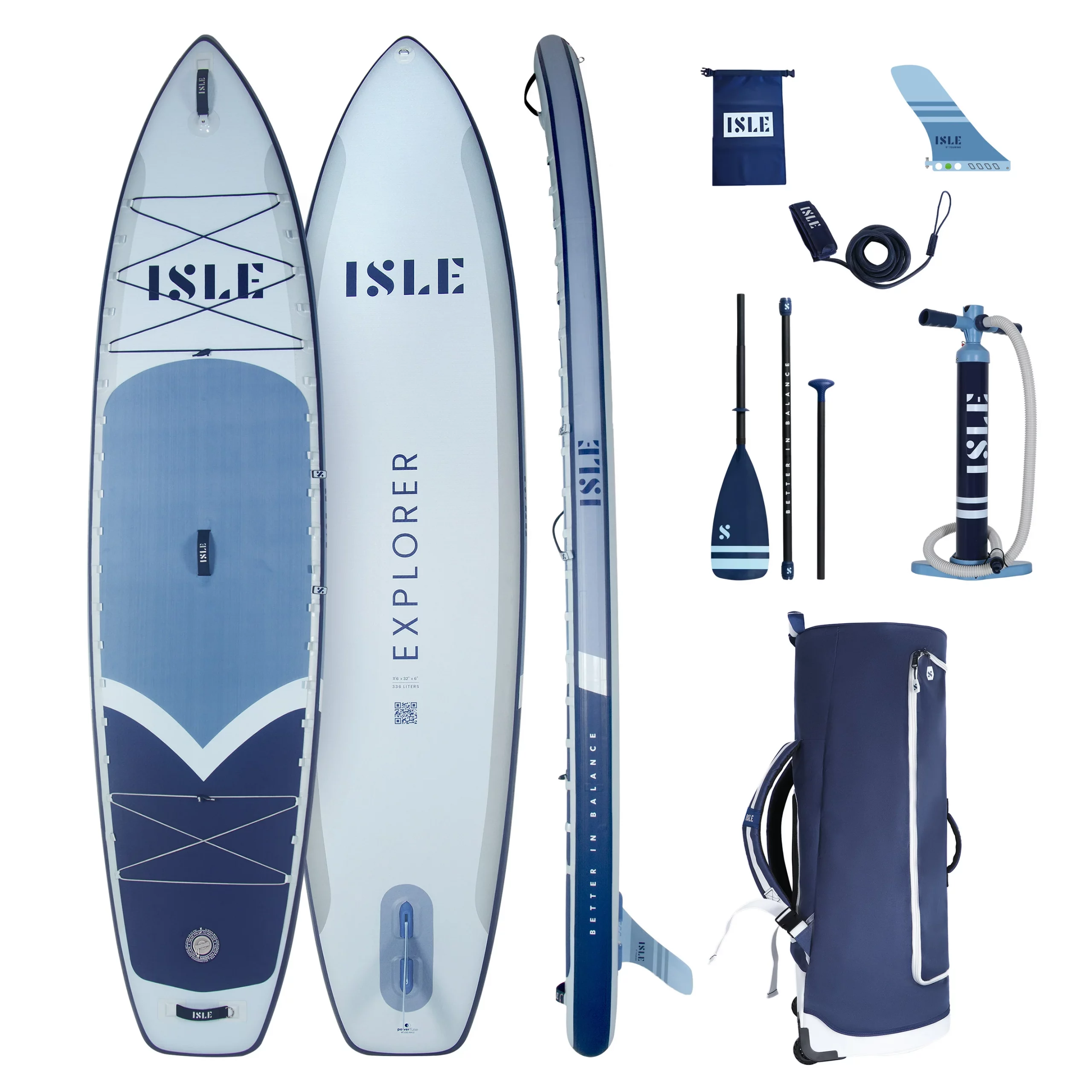
Available Sizes: 11′ 6″
Size Tested: 11′ 6″ x 32″ x 6″
Weight: 24 pounds
Weight Capacity: 300 pounds
Pros: Great all-around design, high-quality construction
Cons: Doesn’t come with any fun extras, but they can be purchased separately
Designed to be a do-it-all paddle board, the ISLE Explorer 3.0 works well for yoga, fishing, surfing, or just general cruising. It’s the perfect blend of quality construction and on-the-water performance, for a reasonable price.
An upgraded model of the beloved Explorer 2.0, the 3.0 offers all of the same features of the former model, with a few upgrades. The Explorer 3.0 sports a touring shape for better glide, but at 32 inches wide, it’s still plenty stable. For a touring board, it’s on the slower side, but for an all-around style iSUP, it’s a speedy one. It’s also 20% lighter than the Explorer 2.0, packs down smaller, and the carry bag now has integrated wheels, which we’re huge fans of for easier transport.
The Explorer 3.0 package comes complete with a travel bag, nylon center fin, a slim hand pump, a three-piece adjustable carbon hybrid paddle, bungee tie-downs on the front and aft of the board, and an eight-foot coil leash. There’s a lot to love about this board, but it doesn’t come with any fun extras like some other boards do (i.e., GoPro mounts, kayak convertible seats/paddles, etc.). However, you can purchase a kayak seat, footrests, and a kayak blade for an additional cost if you wish to transform your SUP board into a kayak. ISLE also offers a wide variety of other accessories to upgrade your paddling experience.
Another contender for the title of Best All-Around is the BOTE Breeze Aero. Both boards have similar overall sizes and similar prices, but we prefer the ISLE because, being a little narrower, it feels noticeably faster on the water. We also like the quality of the included accessories and the comfort of the included carrying bag. Read our full review of the ISLE Explorer 3.0 here.
CHECK PRICE ON AmazonBest Budget Inflatable Paddle Board
ROC Kahuna ($240)
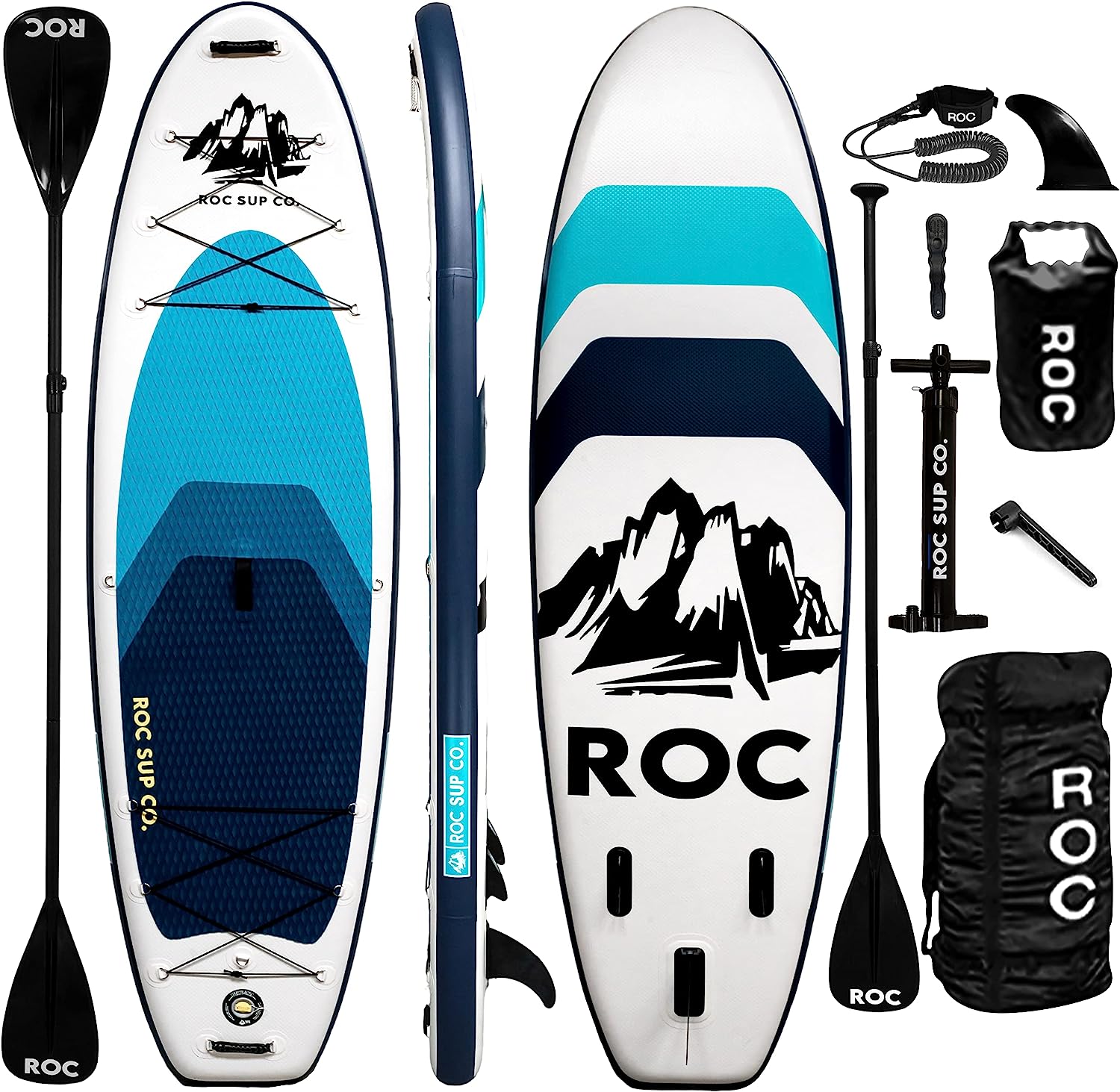
Available Sizes: 10′ Explorer | 10′ Scout | 10′ 6″ Kahuna
Size Tested: 10′ 6″ x 33″ x 6″
Weight: 17.6 pounds
Weight Capacity: N/A
Pros: Affordable, stable
Cons: Not super fast, doesn’t perform well in waves or chop
Finding a budget inflatable paddle board is a bit of a double-edged sword. Sure, cheaper is preferable, but oftentimes, cheap iSUPs are less stable and less durable. Of all the boards we tested, the ROC Kahuna was the perfect blend of affordability without sacrificing much in the performance department.
Measuring 10’6″ x 33″ x 6″, the Kahuna is stable enough for beginner paddlers, families, and even paddling with your pup onboard. Lightweight and compact, the Kahuna is easy to store and transport, but it’s not the most hydrodynamic board we tested, nor does it perform well in waves or chop, being a bit on the softer side. If you’re looking for speed, you might want to look elsewhere. But if you’re looking for a reliably stable board for flatwater paddling, the Kahuna is a great option.
While most budget inflatables don’t come with a lot of extras, the Kahuna does have some fun, thoughtful features. The Kahuna sports front and rear grab handles as well as front and rear cargo rigging, and includes a waterproof dry bag, a collapsible three-piece paddle, a detachable center fin, a leash, and a dual-action pump. You also have the option to purchase a package that includes a kayak seat and kayak-compatible paddle, depending on how you plan on using the board. At the time of publishing, the ROC Kahuna can be found for as low as $240.
Another contender for Best Budget Inflatable Paddle Board is the Funwater Discovery ($220). Often on sale for $200 or less, this is about as low as we would go for an inflatable SUP while still maintaining some standard of quality. Ultimately, we chose the ROC Kahuna for its added value with the kayak accessories. Learn more in our Inflatable Paddle Boards Review, or read our full review of the ROC Kahuna.
CHECK PRICE ON AMAZONRunner-Up Best Inflatable Paddle Board
BOTE Breeze Aero ($779)
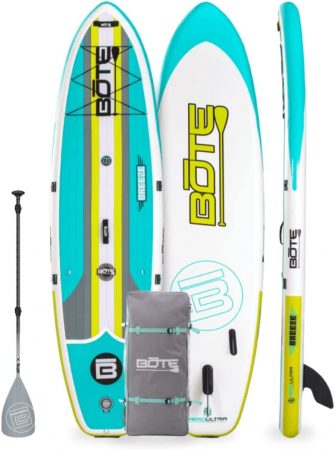 Available Sizes: 10′ 6″ | 11′ 6″
Available Sizes: 10′ 6″ | 11′ 6″
Size Tested: 11′ 6″ x 33″ x 6″
Weight: 22 lbs
Weight Capacity: 315 pounds
Pros: Good stability without sacrificing too much speed, compatible with wide range of BOTE accessories
Cons: Not the fastest board out there
The BOTE Breeze Aero is another great all-around inflatable paddle board the provides a balanced overall paddling performance, and offers a solid value. With its 33-inch width and rounded shape, it provides great stability in choppier conditions, helping inspire confidence in timid paddlers. mid-tier inflatable SUP that provides a great blend of paddling performance and value.
Similar to other inflatable paddle board kits, the Breeze Aero includes all the gear and accessories you need to hit the water, and is compatible with a wide range of extra accessories that BOTE is becoming famous for, including carry straps, coolers, inflatable seats, drink holders, and magnetic speakers.
The Breeze Aero is a great all-around board, but our testing team slightly prefers the on-water performance of the ISLE Explorer 3.0. The ISLE is a bit smoother and faster on the water, though not quite as stable in rougher conditions as the Breeze Aero. And while BOTE has a wider range of available accessories, we really like the accessories that come standard on the ISLE. A littler wider and more stable, the Breeze Aero is a better pick for beginner paddlers. Read our full review of the BOTE Breeze Aero here.
CHECK PRICE ON BOTEBest All-Around Hard Paddle Board
Surftech Lido ($995)
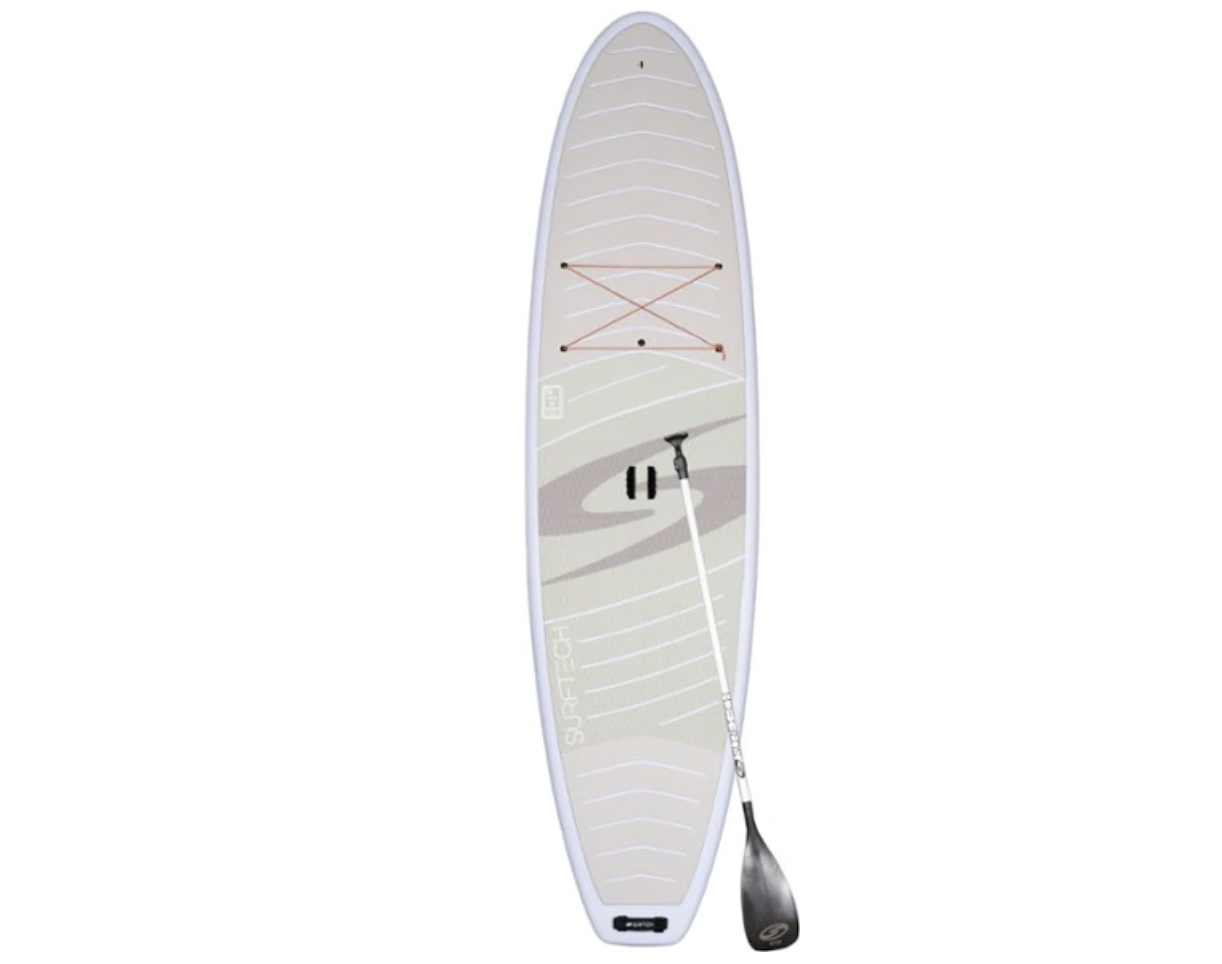
Available Sizes: 10′ 6″ |11’6″
Size Tested: 10’6″′ x 32″ x 5″
Weight: 24 pounds
Weight Capacity: 300 pounds
Pros: Manageable size, durable Utility Armor construction
Cons: Cutout grooves/lines on the deck pad aren’t super comfortable
If you prefer to skip the hassle of inflating and deflating your board each time you paddle, the Surftech Lido is a great all-around hard paddle board that comes in a manageable size. At 10’6″, the Lido is easy to load and unload from your vehicle, and the versatile shape makes it well-suited for paddling on waves, flat water, and everything in between.
Made with Surftech’s Utility Armor construction, the Lido utilizes EPS foam, high-quality fiberglass, epoxy resin, reinforced rails, and a molded Utility Armor shell. The result? A durable board that seems capable of withstanding the test of time.
The Lido includes an adjustable paddle and a 9″ center fin — paddles can cost a pretty penny, so the fact that one is included is a huge plus. The BLOOM foam algae deck pad covers the majority of the board, so yoga and/or fancy footwork is a viable option. While we appreciated having something slip-free to stand on, our lead tester didn’t love the cutout grooves/lines in the deck pad.
The hull-shaped nose allows the board to glide well through the water despite its width, but the Lido isn’t as fast as some longer or skinnier options. Stability and all-around performance are the name of the game, and the Lido includes extras like deck bungee straps for stashing gear and two grab handles (middle, recessed, and rear, padded) that make it easy to transport. Paddlers who want a do-it-all hardboard for a reasonable price will love the Surftech Lido.
When choosing the best all-around hardboard, it was a tough call between the Lido and the BOTE Breeze Gatorshell, featured below. Both boards sport all-around shapes, include bungees on the nose, have a single fin, and have similar measurements. However, the Breeze is a bit heavier, and sports a more stable outline, with a wider nose and tail. This makes it a better option for beginner paddlers, but it’s also slower and less efficient for longer paddles.
CHECK PRICE ON REIRunner-Up Best Hard Paddle Board
BOTE Breeze Gatorshell ($1,129)
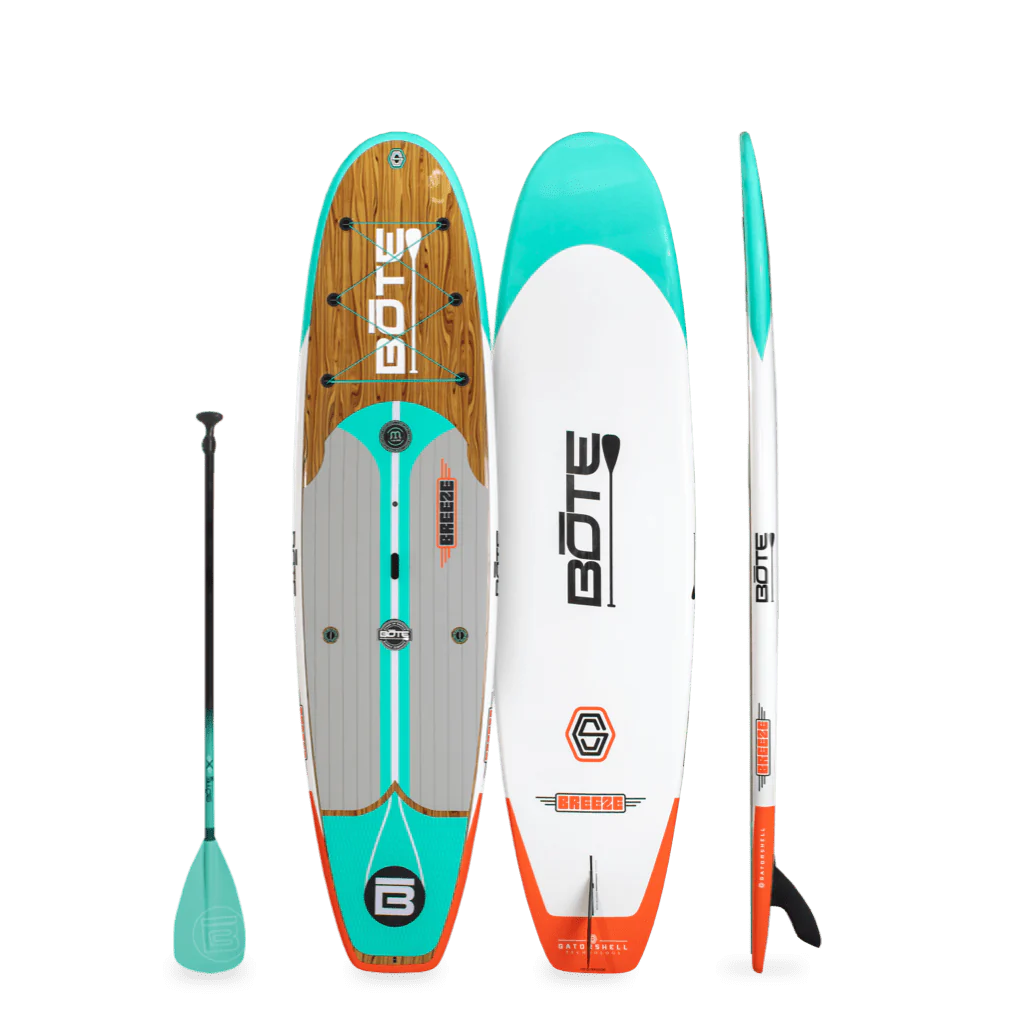
Available In: 10’6″, 11’6″
Size Tested: 10’6″ x 32″ x 4.5″
Weight: 31 pounds
Weight Capacity: 230 pounds
Pros: Super stable, very durable construction, compatible with BOTE accessories
Cons: Heavy, included paddle isn’t great
If stability is what you’re after, the BOTE Breeze Gatorshell delivers. Measuring 10’6″ x 32″ x 4.5″, the Breeze sports an all-around shape that provides a wide, stable platform for paddlers. If you’re new to paddling or simply enjoy a stable board that works across a wide range of conditions, the Breeze gets the job done.
Although the Breeze performs well in a multitude of conditions, the board shape doesn’t have a lot of rocker, so we found that water went over the nose in rough or choppy conditions. Although the long and wide construction delivers a stable ride, the Breeze is fairly heavy and difficult to carry far – this is a board you’ll want to use directly from the dock or from parking lots where the walk to the water is short. If you need something a little lighter, an inflatable board like the ISLE Explorer 3.0 is a great option, as it is much easier to store and transport.
The Breeze Gatorshell (we tested it in the Cyprus colorway) has a cool aesthetic, with a faux wood nose and bright pops of color throughout. The deck pad feels good underfoot, and the front bungees are the perfect place to stash shoes, packs, water, and any other essentials you wish to pack along for your adventure. The board is also compatible with lots of fun accessories like BOTE’s Kula Cooler and cups/bottles that attach to the board via a unique magnet system.
The Breeze Gatorshell is made with BOTE’s signature Gatorshell construction that combines ABS plastic with ballistic-grade composites, delivering an incredibly durable board. Although the board itself is high quality, the included paddle isn’t, and the shaft slipped around a lot while paddling. All and all, the Breeze promises a stable ride for a wide range of paddlers. However, advanced paddlers will appreciate a more performance-oriented board like the Surftech Lido, above, or the Pau Hana Malibu Tour, featured below.
Check Price on REIBest Hard Paddle Board for Casual Touring
Pau Hana Malibu Tour ($999)
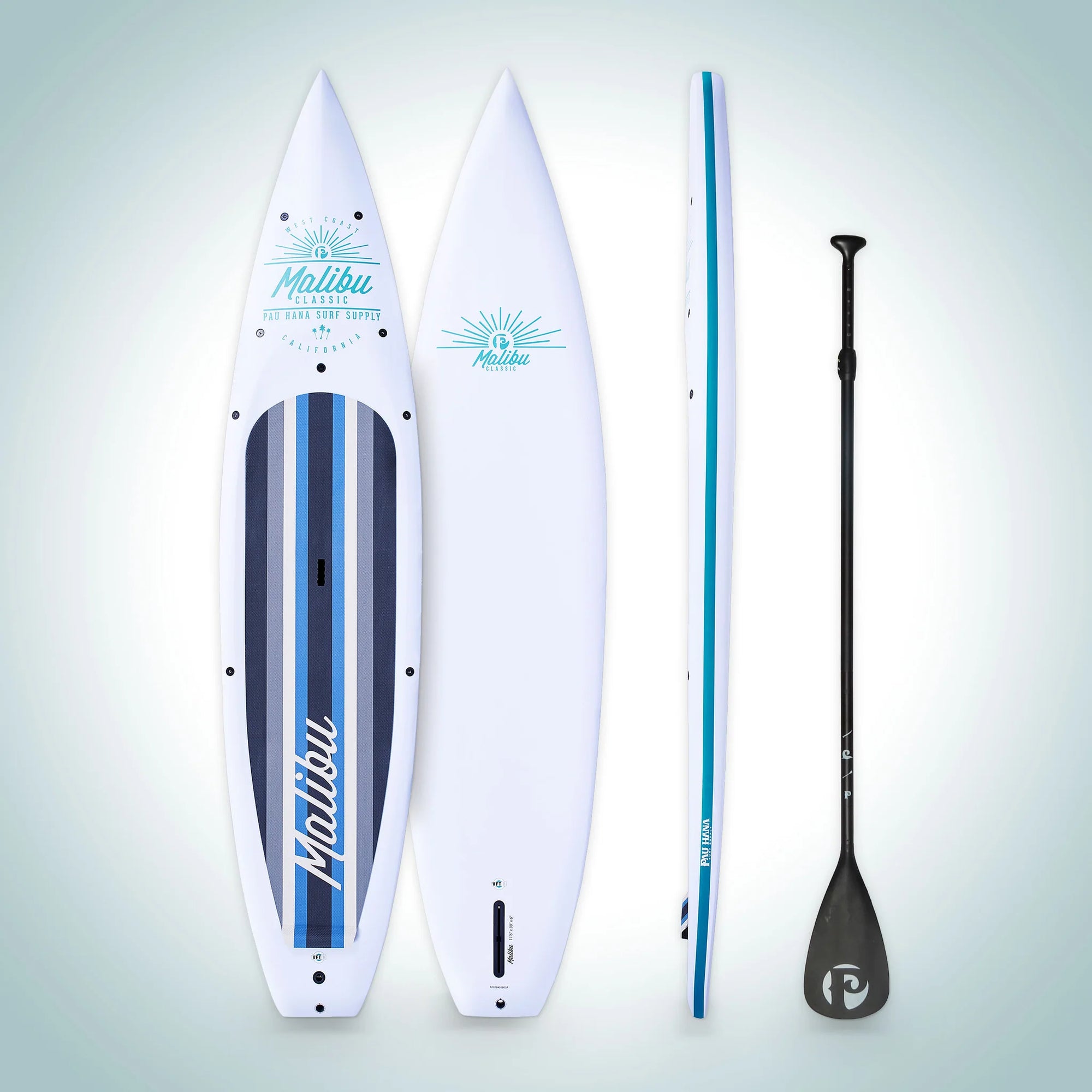
Available Sizes: 11’6″
Size Tested: 11’6″ x 30″ x 6″
Weight: 31 pounds
Weight Capacity: 192 pounds
Pros: Paddles efficiently, cool aesthetic, includes bungee tie-down straps
Cons: Heavy, low weight capacity, paddle isn’t secure
Designed to cover long distances quickly, the Pau Hana Malibu Tour measures 11’6″ x 30″ x 6″. The high volume and width provide stability, while the length and pointed nose allow it to cut through the water efficiently.
The Malibu Tour sports a single fin setup and multiple attachment points along the rails, so you can attach the included bungee straps to your liking. While we appreciated that we could configure the straps however we liked, we would have preferred that the bungees come attached, as we found that the manufacturers tend to be better at rigging them than we are.
The Malibu Tour also includes an adjustable paddle. We liked how easy it was to adjust, but we highly recommend tightening it a bit extra once you find your desired height, as we found that otherwise it slid down when we applied decent pressure to the handle.
The Malibu Tour is incredibly durable: Vacuum Formed Technology construction wraps the EPS foam core, and Kevlar reinforcement lines the rails. We appreciated the durable design but found that the board was heavy to lug to and from the car.
We had both a first-time paddler and a seasoned paddler test this board, and both loved it. The beginner felt that it was stable enough to get his bearings, while our experienced paddler appreciated that it delivered a blend of speed and stability.
If you’re short on space or simply prefer the convenience of an inflatable SUP, the Red Paddle Co. Sport Plus is a similar touring-style board, but it’s lighter and much more packable. Both boards track well through the water and include tie-down straps on the nose for attaching gear for long paddling adventures.
CHECK PRICE ON REIBest All-Around Surf Paddle Board
Surftech Generator V-Tech ($1,330)
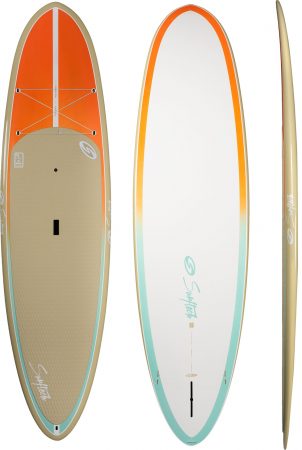
Available In: 10’6″, 11’6″
Size Tested: 10’6″ x 32″ x 4.4″
Weight: 27 pounds
Weight Capacity: 175 pounds
Pros: Durable, lightweight construction, versatile
Cons: SUP surfers looking for a high-performance ride should scope out our other surf SUP options below
As newer paddlers begin to get their feet more firmly planted underneath them, they may start to think about testing their newfound skills in the waves. If they started out on a nice, boaty all-around SUP, that board won’t serve them for long in the surf. The Surftech Generator is a board that nails the sweet spot in terms of solid enough stability for most flatwater paddling, as well as having the surf chops necessary to give the rider the potential to ride in a variety of surf conditions. If you’re looking for one board to do it all, the Generator is a compelling option.
With the smallest size being a 10’6″, you won’t get anywhere near as much surfing performance as the Quatro Carve Pro or Naish Mad Dog below, but with a pintail, 2+1 fin setup, a bit of nose-flip to keep you from pearling (burying the nose as you paddle into a wave), and a rocker outline that prioritizes surfing over flatwater cruising, even experienced SUP surfers might be surprised by how much fun this board is.
A grippy deckpad extends all the way to the tail, but the board doesn’t have a kickpad to keep your back foot from sliding off. This, along with the front webbing, shows the board is meant to be more than just a surf SUP, and the board’s performance on flat water backs up this claim. While it’s not quite as stable as all-around boards like the Surftech Lido or BOTE Breeze Gatorshell, it’s surprisingly approachable for new paddlers. However, heavier riders and absolute beginner paddlers who are compelled by this surf-crossover design may want to look at the 11’6″ version.
Check Price on REIBest High-Performance Surf Paddle Board
Quatro Carve Pro ($1,989)
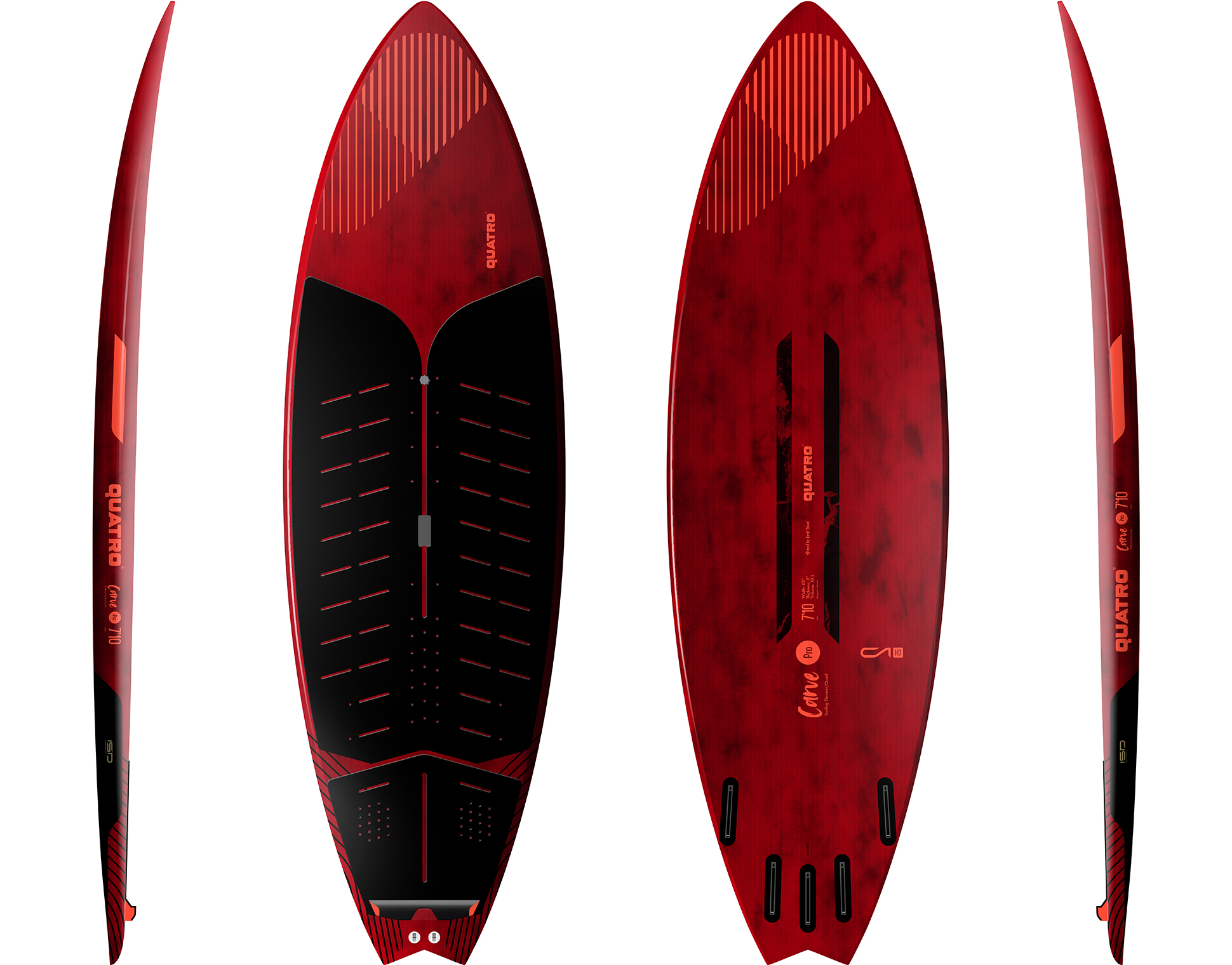
Available In: 7’7″, 7’10”, 8’0″, 8’2″, 8’4″, 8’7″
Size Tested: 8’0″ x 28.5″
Weight: 14 pounds
Weight Capacity: N/A
Pros: Well-designed tail, lightweight, durable
Cons: A little pricey
When it comes to SUP surfing, the Quatro Carve Pro is the best board we’ve tested for the job. We tried the Carve Pro in glassy conditions, choppy waves, and at a punchy beachbreak to get a feel for how it performed in a wide range of conditions, and it took them all on with ease. Quatro is a brand that is well-known for making high-performance equipment for kiting, foiling, surfing, and SUP, and the Carve Pro is no exception.
The Carve Pro features Quatro’s Pro Light Full Double Sandwich Construction, which allows the board to be extremely lightweight (just under 14 pounds). As such, the board is easy to transport and handle on the water. While up and riding on a wave, the board feels and performs similarly to a shortboard. In particular, the Carve Pro rides similarly to a performance fish, and the length coupled with the bottom contours makes it easy to paddle.
The Carve Pro features a high nose lift combined with a narrow nose width that helps with late drop-ins, thin rails for tighter turns, a narrow width, a shallow tail, and an integrated Stability Deck Pad to add grip without wax or needing to install your own deck pad. The board has a five-fin box setup and comes with Quatro-brand fins, allowing you to experiment with a thruster or quad setup.
Our tester is 6’0″, and an advanced paddler. He found that the 8’0″ length combined with the 28.5″ width was the perfect size for him. The board comes in a bunch of additional sizes, so it’ll be easy to find one that works well for you. It’s not a cheap board, but it’s fun to surf and the quality is exceptional.
If you’re looking for a more affordable board, the Naish Mad Dog is a bit cheaper while still being a versatile, high-performance board. In terms of volume and size, the boards are very similar, but the Quatro is significantly lighter. Those looking for a more approachable board for SUP-surfing should check out the Surftech Generator, above.
Check Price on QuatroMore Great Stand Up Paddle Boards
The above list highlights our top picks for each different board category, but our team also tested dozens of other boards. The list below includes additional standouts that we’d recommend.
Best Foam Stand Up Paddle Board
Wavestorm SUP Yak ($600)
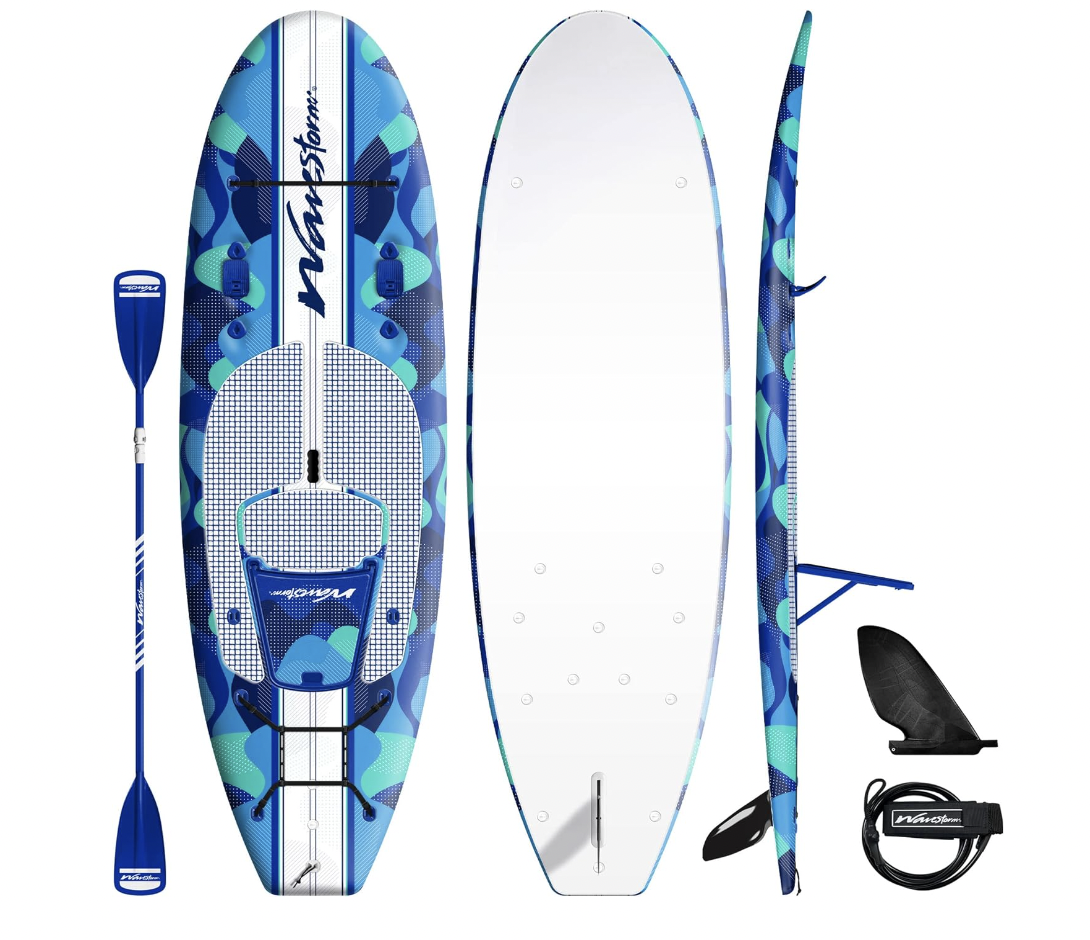
Available In: 9’6″
Size Tested: 9’6″
Weight: 35 lbs
Weight Capacity: 300 lbs
Pros: Built-in kayak accessories make for a smooth transition
Cons: Heavy, handle isn’t comfortable to carry
If you’ve ever been surfing, or been to a surf town, or been to Costco for that matter, you’ve undoubtedly seen a Wavestorm surfboard. Wavestorm loyalists, get ready to be excited: Wavestorm makes a foam stand up paddle board. The Wavestorm SUP Yak is a hybrid SUP that works as both a kayak and a SUP.
Upon first glance, the SUP Yak doesn’t appear incredibly stable, but once we took it on the water, we quickly learned that looks are deceiving. Thanks to its 33″ width and 7″ thickness, the SUP Yak feels solid underfoot. We had experienced and novice paddlers try the SUP Yak and all reported back that they felt stable while paddling the board and appreciated its smooth ride. This is a paddle board anyone can enjoy.
Unlike other hybrid SUPs we’ve tried, the SUP Yak has the kayak seats and footrests built into the board. So, when you’re ready to switch to kayak mode, you simply have to flip up the seat and switch out the paddle handle for the kayak blade. The board is highly functional as a kayak, and the three different positions for the footrests help you find a comfortable spot. We appreciate that the kayak seat and footrests are built in for an easy transition, but sometimes we wish they were removable for surfing or when paddling with multiple riders onboard. Read our full review of the Wavestorm SUP Yak here.
CHECK PRICE ON AMAZONBest Inflatable SUP/Kayak Hybrid
BOTE LowRider Aero ($899)
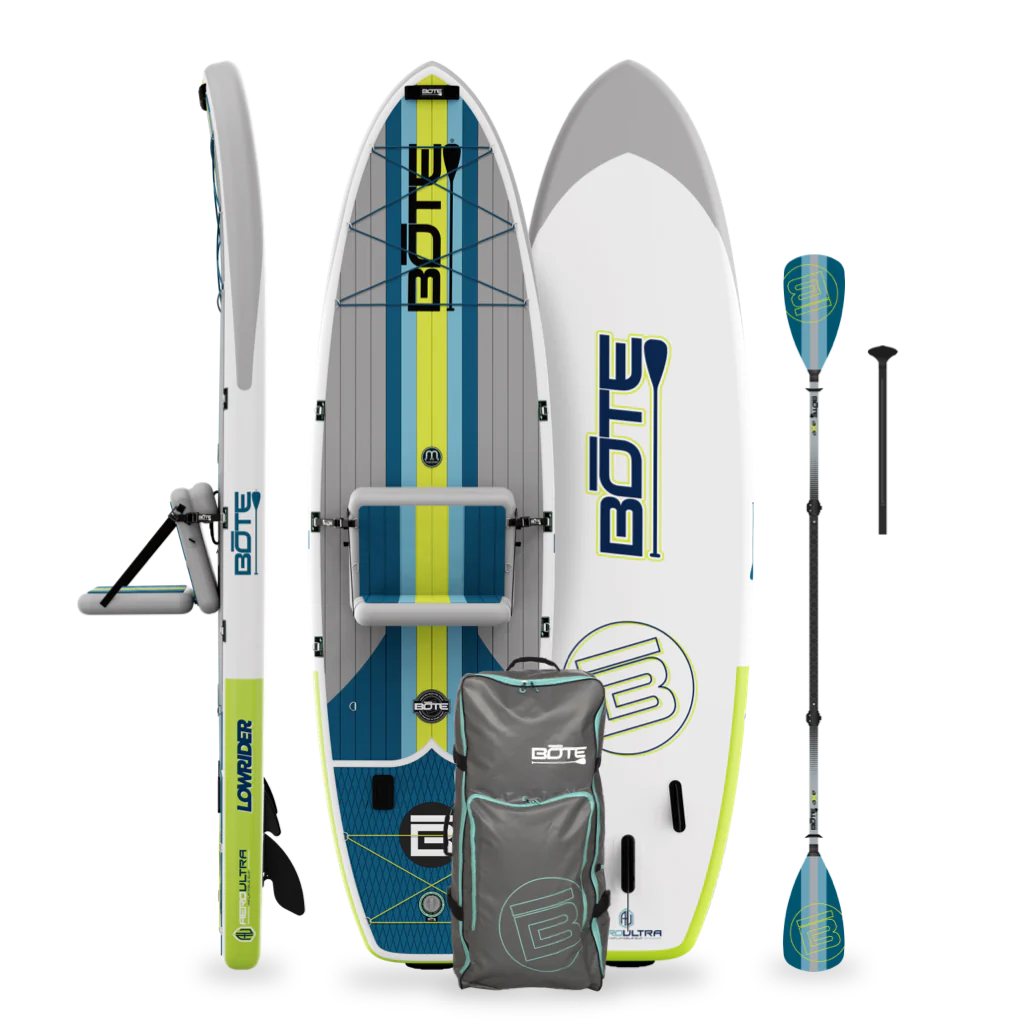
Available Sizes: 10’6″, 11’6″
Size Tested: 10′ 6″ x 36″ x 6″
Weight: 30 lbs
Fin Configuration: 2+1 fins, center fin is removable
Pros: Comes with a kayak seat/paddle, incredibly stable
Cons: Large/heavy
Investing in a paddle board isn’t cheap, and oftentimes it requires sacrificing something else you want, like, say, a kayak. The BOTE LowRider Aero is a best-of-both-worlds hybrid board and includes all of the accessories to quickly convert it from a SUP to a kayak.
Measuring 10’6″ x 36″x 6″, the LowRider is very wide and consequently super stable in either mode. Because it’s such a large board, getting it inflated is no walk in the park. At 30 pounds, the board is on the heavy side for an iSUP, but luckily, the bag has padded shoulder straps and wheels. Despite its size, the LowRider cuts well through the water and was much easier to maneuver than we anticipated.
Most iSUP packages we tested come with cheaply made paddles, so the four-piece hybrid carbon/fiberglass paddle that comes with the LowRider was a pleasant surprise. It’s surprisingly sturdy and has a nice grip along the shaft, a major plus. The LowRider was designed with all sorts of adventures in mind and is compatible with BOTE’s racks and coolers, so you can use it for fishing as well. Because it’s so large, it’s not as well-suited for longer tour-style paddling adventures, but for shorter cruises and all-around use, it works great.
The ISLE Explorer 3.0 can also be setup as a kayak, but you must purchase the kayak accessories separately, whereas the LowRider includes them in the package. At $899, it’s an incredible deal for a kayak and paddle board in one. Read our full review of the BOTE LowRider here.
CHECK PRICE ON REI Check Price on Amazon
A Unique Touring/All-Around Crossover
Surftech Chameleon Tuflite V-Tech ($1,155)
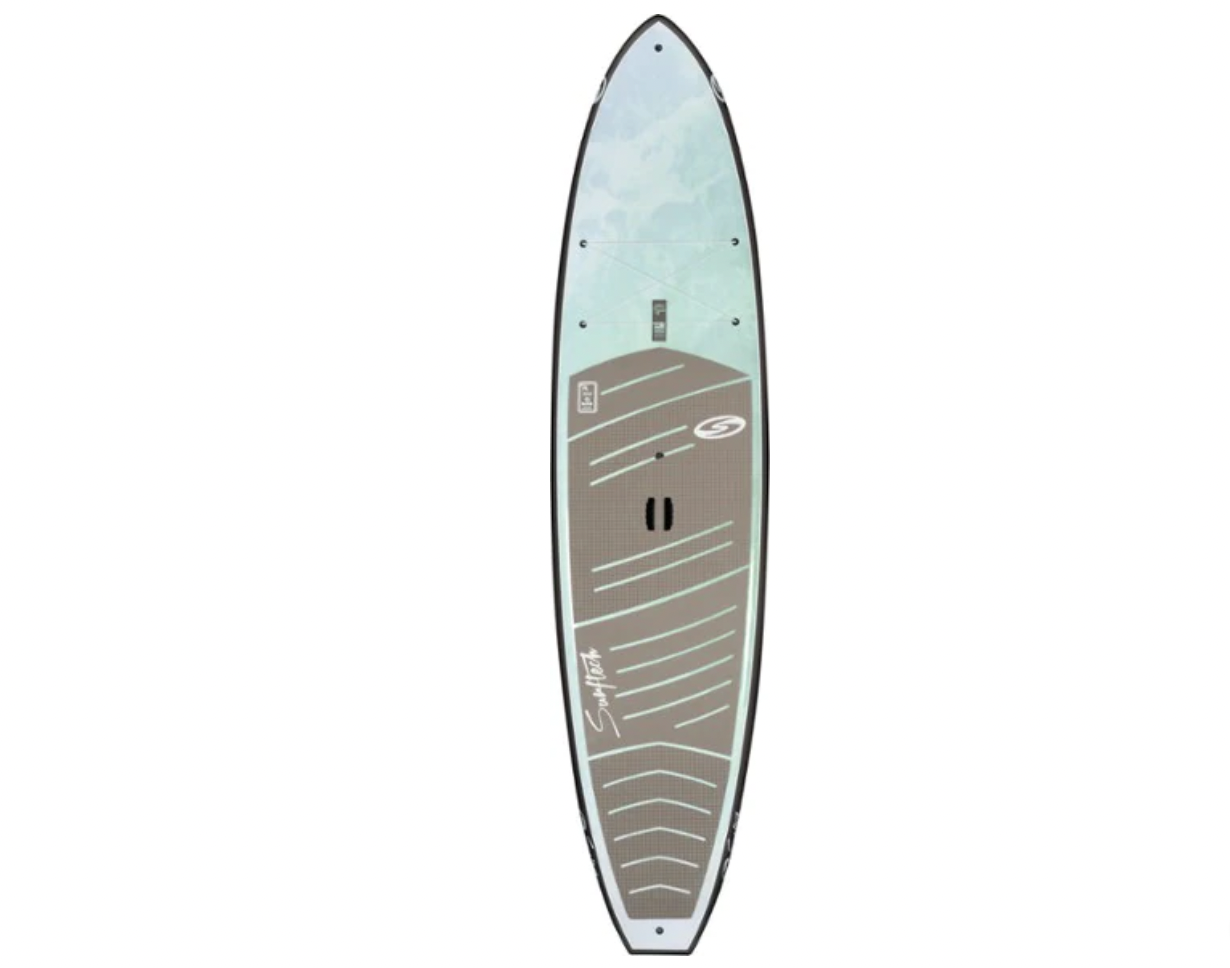
Available In: 10’4″, 11’4″
Size Tested: 11’4″ x 32″ x 4.5″
Weight: 25 pounds
Weight Capacity: 225 pounds
Pros: Nice aesthetic, v-shaped nose cuts easily through the water
Cons: Narrower shape and lower volume aren’t our top choice for less-experienced paddlers
At first glance, we really love the look of the Surftech Chameleon Tuflite V-Tech. It has nice graphics, and the entire aesthetic is appealing. But looks don’t mean anything if it doesn’t perform on the water. Luckily, the Chameleon combines those good looks with a high-performance shape that’s a joy to paddle.
The “hybrid” shape takes the stability of an all-around paddleboard and gives it a slimmed-down profile and a slight V-shape nose similar to a touring-style paddleboard that helps it cut through the water. Tack on a planing hull that helps with stability and maneuvering, and you get a smooth glide and plenty of speed through the water, with surprisingly solid stability to boot. At 4.5” thick, the Chameleon is thinner than most boards, giving the board a low center of gravity that makes you feel like you’re walking on water. While the board is plenty stable for a beginner in calm, flat water conditions, it’s not as stable in really rough, choppy water as thicker or wider boards.
Thoughtful features include a single center fin, 3/4 length deck pad, deck tie-down straps on the nose of the board, and a recessed grab handle for easy transport. While it was nice to have reliable traction underfoot, our lead tester wasn’t a fan of the feel of the cutout grooves/lines in the deck pad. Weighing in at 25 pounds, the Chameleon is on the lighter side for an 11’4″ board, which we greatly appreciated when loading and transporting it.
The Chameleon is a similar size and shape to the Red Paddle Co. Sport Plus, although the Sport Plus is a bit longer and narrower, staying true to the touring style of paddleboard. Despite being a hard board, whereas the Sport Plus is an inflatable, the Chameleon is only a couple of pounds heavier.
CHECK PRICE ON REIAnother Great All-Around Hard Board
Surftech Bark Catalyst ($1,485)
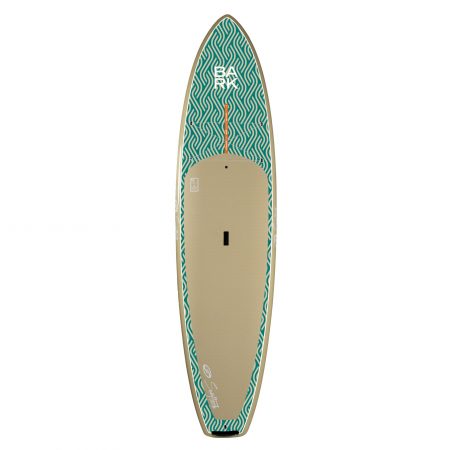 Available Sizes: 11’2″
Available Sizes: 11’2″
Size Tested: 11’2″ x 32.5″ x 4.8″
Weight: 24 lbs
Weight Capacity: N/A
Pros: Good all-around performance, nice aesthetics, capable of surfing waves
Cons: Lower weight capacity makes it less stable
The Bark Catalyst from Surftech is a fun and cool-looking stand up paddle board created by legendary California board shaper Joe Bark. Similar in size and shape to many other SUPs on the market, the Catalyst was designed primarily for flat water paddling, but is said to be capable of handling small to medium surf as well. Though we were only able to paddle it on the flat waters of Lake Tahoe, we’d describe the flatwater performance as very playful and maneuverable, thanks to its rockered shape and lower overall volume.
The Catalyst is a capable all-around board, but because it is so playful and maneuverable, it’s also quite a bit less stable than most other hard and inflatable boards that we tested. While our veteran paddlers could certainly handle a few noticeable wobbles through some normal chop and boat waves on Lake Tahoe, novice paddlers likely won’t feel as comfortable. This board would be most ideal for an experienced coastal paddler who tackles both waves and flatwater, and can more confidently take advantage of the board’s fun and playful performance.
Check Price on REI Check Price on Surftech
Best Inflatable Paddle Board for Touring
Red Paddle Co. Sport Plus ($1,349)
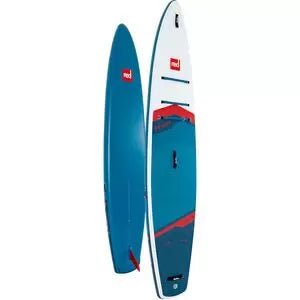
Available Sizes: 12’6″, 14′
Size Tested: 12’6″ x 28″ x 4.75″
Weight: 21 lbs
Weight Capacity: 250 lbs
Pros: Hydrodynamic and fast, quality accessories, RSS battens make it feel like a hard board
Cons: Doesn’t come with a paddle, might not be stable enough for beginners
Created with distance and speed in mind, the Red Paddle Co. Sport Plus is one of the fastest inflatables we’ve tested. Measuring 12’6″ x 28″ x 4.75″, the Sport Plus is narrower and thinner than most inflatable paddle boards, allowing it to cut through the water efficiently and quickly. Newer paddlers may have trouble with the narrower shape, but we found the board to be pretty stable.
To help make the board feel as rigid as possible, it comes with a rocker stiffening system where you insert plastic battens into the side of the board. You can paddle without them, but they make the Sport Plus feel more like a hard board than your average inflatable, which we think is pretty cool.
The Sport Plus comes with all the bells and whistles: a wheeled storage bag, the RSS battens, a fin, leash, repair kit, cell phone case, and a twin chamber pump. Testing the 12’6″ version, we found it doesn’t pack down as small as some of the other inflatables we tried, so the wheeled bag was a huge plus and made it surprisingly easy to transport (you can even travel with it as your checked bag). The price is steep, but the board’s performance is stellar, and its durable design makes it a great touring option for those who prefer an inflatable SUP.
If you prefer a hard board, the Pau Hana Malibu Tour is another great touring option. It’s slightly shorter and wider, but the paddling performance is similar to the Sport Plus due to the hard board construction. Both have bungee tie-downs for hauling gear, and both track well through the water. The Malibu Tour is heavier (31 pounds to the Sport Plus’s 21). Read our full review of the Red Paddle Co. Sport+ here.
Check Price on Green Water Sports Check Price on Red Paddle Co.Best Value Surf SUP
Naish Mad Dog ($1,929)

Available In: 7’6′, 7’10”, 8’1″, 8’6″, 8’11”
Size Tested: 7’10” x 29″ x 4.25″
Weight: N/A
Weight Capacity: 180 lbs
Pros: Well-designed, shortboard feel, good value
Cons: Material is a little heavier than our top-pick options
Robby Naish has been in the watersports industry for years, and he’s learned a thing or two about making boards through his experiences. The Naish Hokua has been a longtime top pick among SUP surfers, but we opted to place the Mad Dog on our list instead due to its speed and responsiveness. It’s also super easy to paddle, but it feels like you’re riding a shortboard. Construction-wise, this board was not quite as light as our other top-pick SUP surf options, but that’s to be expected given the much lower price tag.
We took the Mad Dog out in an eight-foot winter swell in Oregon and loved the speed and responsiveness the quad setup delivered. This may not be true for some of the larger models, but we tested out the 7’10” and found it was a great board for bigger surf.
While we loved the Mad Dog in bigger surf, we also had the chance to test it on a small day and appreciated how versatile the board is. The 4+1 quad/single fin setup with FCS fins allows for a quad, single-fin, or 2 + 1 setup, which further adds to the versatility of the board. The Mad Dog features a Sandwich Deck Construction, with bamboo in the stance area and a diamond-grooved EVA deck pad. The rocker is forgiving, but it’s built for performance and is best suited for pumping waves. Of all the SUP surfboards we got our hands on, the Mad Dog was the most affordable board without sacrificing performance.
When it comes to specs, the Mad Dog is very similar to the Quatro Carve Pro. It’s cheaper than the Quatro, but it’s also a bit heavier, which makes it more difficult to carry and push hard through turns. The Mad Dog is a great pick for bigger days, whereas the Carve Pro is the move if you’re going for late drop-ins and tight turns.
Check Price on NaishHonorable Mentions
There are so many incredible stand up paddleboards on the market, and we simply couldn’t include them all without overwhelming you with options. This review highlights the best of the best paddleboards that we tested, but there are a few more that we’d like to call out here.
The SIC Maui RST Race Board is an incredible board designed for all-conditions SUP racing, but this super speedy and feature-loaded machine’s price tag of $3,600 will keep it out of reach for most recreational paddlers.
The Infinity Widespeed is another top-tier choice of ours, this one in the SUP Surf category, but we found the Quatro Carve Pro and the Surftech Generator to be better choices for a wider audience.
Other awesome all-around paddle boards we’ve tested include the Starboard GO and the Naish Nalu.
Best Stand Up Paddle Boards Comparison Table
| Board Model | Price | Dimensions | Weight | Weight Capacity | Fin Configuration | Volume |
| ISLE Explorer 3.0 | $795 | 11′ 6″ x 32″ x 6″ | 24 lbs | 300 lbs | 2 + 1 | 336 liters |
| ROC Kahuna | $240 | 10′ 6″ x 33″ x 6″ | 17.6 lbs | N/A | 2 + 1 | N/A |
| BOTE Breeze Aero | $779 | 11’6″ x 33″ x 6″ | 22 lbs | 315 lbs | 2 + 1 | N/A |
| Surftech Lido | $995 | 10’6″′ x 32″ x 5″ | 28 lbs | 300 lbs | Single | 236 liters |
| BOTE Breeze Gatorshell | $1,129 | 10’6″ x 32″ x 4.5″ | 31 lbs | 230 pounds | Single | N/A |
| Pau Hana Malibu Tour | $999 | 11’6″ x 30″ x 6″ | 31 lbs | 192 lbs | Single | 234 liters |
| Surftech Generator V-Tech | $1,330 | 10’6″ x 32″ x 4.4″ | 27 lbs | 175 lbs | 2 + 1 | 167 liters |
| Quatro Carve Pro | $1,989 | 8’0″ x 28.5″ | 14 lbs | N/A | Thruster or Quad | 109 liters |
| Wavestorm SUP Yak | $600 | 9’6″ x 33″ x 7″ | 35 lbs | 300 lbs | Single | 195 liters |
| BOTE LowRider Aero | $899 | 10′ 6″ x 36″ x 6″ | 30 lbs | 300 lbs | 2 + 1 | 368 liters |
| Surftech Chameleon Tuflite V-Tech | $1,155 | 11’4″ x 32″ x 4.5″ | 25 lbs | 225 lbs | Single | 213 liters |
| Surftech x Bark Catalyst | $1,485 | 11’2″ x 32.5″ x 4.8″ | N/A | N/A | Single | 203 liters |
| Red Paddle Co. Sport Plus | $1,349 | 12’6″ x 28″ x 4.75″ | 21 lbs | 250 lbs | Single | 252 liters |
| Naish Mad Dog | $1,719 | 7’10” x 29″ x 4.25″ | N/A | 180 lbs | Quad setup | 101 liters |
How We Tested the Best Stand Up Paddle Boards
To get a feel for how these boards performed in a wide range of conditions, our expert team of paddlers hit the water in Oregon, California, and Hawaii, paddled in alpine lakes, the open ocean, on rivers, streams, and canals, and surfed some of the Pacific’s best waves. With each board, we considered its intended use, overall stability, how it tracked through the water, glide, how it felt underfoot, and how difficult or easy the board was to transport. We considered whether the board was sold solo or if it was part of a package. If it came as a part of a package, we evaluated everything that was included, such as fins, leashes, paddles, pumps, bags, and everything else.

Our lead tester, Nick Bruckbauer, taking the Surftech Lido out for a spin. Photo: Shannon Bruckbauer//The Inertia
Leading our testing team are Nick Bruckbauer, Rebecca Parsons, and Joe Carberry. Nick first discovered the sport of SUP in 2011 on a trip to Hawaii. Since then, he’s been a regular on the water and has owned a number of rigid and inflatable boards. He has personally written about 25 different boards for various outdoor publications, as well as testing other paddling gear like SUP paddles and life jackets. Nick currently resides in the Lake Tahoe region and paddles as often as the weather allows.
Rebecca stand up paddled for the first time in 2012, while on a retreat in Lake Tahoe. From there, she became heavily invested in the sport and took up a job writing for SUP the Mag. Since then, she’s competed in numerous races and has SUP-surfed around the world. These days, you’ll find Rebecca training and paddling near her home in Hawaii Kai, Hawaii, oftentimes with her pup, Koa, in tow.
Joe Carberry is The Inertia’s managing editor. But he’s a waterman first. He’s been surfing, paddling, and taking serious, often-unintended beatdowns for nearly three decades, and lent his wealth of knowledge to our efforts here, personally testing a wide variety of surf SUPs.
We originally ran this Guide in 2023. In our May 2024 update, we swapped out the ISLE Explorer 2.0 for the updated Explorer 3.0, and added the Wavestorm SUP Yak as a great pick for a foam paddle board. In July of 2024, we added two new hard boards, the Pau Hana Malibu Tour and the ISLE Cruiser 2, and updated the overall user-friendliness of the guide. In October of 2024, we added the Surftech Generator as a more approachable surf SUP option and added some honorable mentions from prior testing.
We once again update this guide in June of 2025, updating our inflatable touring option from the Red Paddle Co. Voyager to the all-new Red Paddle Co. Sport Plus, and also including the BOTE Breeze Aero as a great option for beginner paddlers. In September of 2025, we added the Bark Catalyst from Surftech, removed some outdated models, and shuffled around some of our top picks to represent our continued testing and to bring more approachable choices to the forefront.
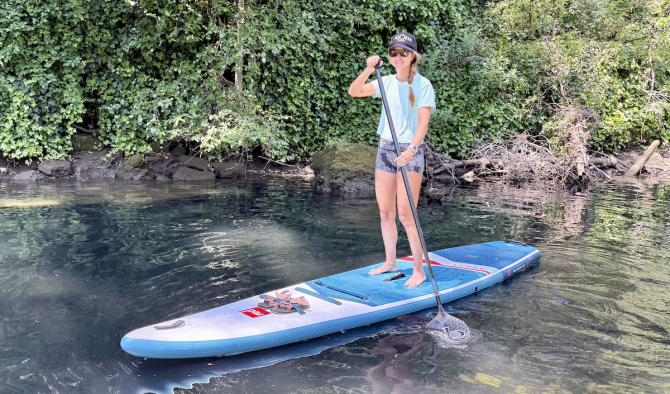
The Red Paddle Co. Sport Plus is a great board for long paddles. Photo: Rebecca Parsons//The Inertia
How to Choose the Best Stand Up Paddle Board
Solid Stand Up Paddle Boards
There are two main types of paddle boards: traditional hardboards and inflatables. Hardboards usually have a foam core that is encircled by fiberglass and epoxy resin. A huge pro of hardboards is that they’re rigid and stiff, allowing them to be more stable and cut through the water easily. They require little to no setup time once you arrive at your destination, but they are often heavy and can be cumbersome to store and transport.

If you prefer to skip the hassle of inflating and deflating your board each time you paddle, the Surftech Lido 10’6″ is a great all-around board that comes in a manageable size. Photo: Nick Bruckbauer//The Inertia
The epoxy or fiberglass shells can be prone to dents, scratches, and dings, so you need to handle them with care when transporting. Hardboards also tend to be more expensive than their inflatable counterparts. If you’re looking for performance, however, hardboards deliver, and they easily maintain speed and momentum while paddling.
| Pros | Cons |
| Little to no setup/take down required | Heavy |
| Rigid and stiff | Large to store and difficult to transport |
| Easily maintain speed and momentum | Expensive |
| Optimized paddling performance | Fiberglass and epoxy are prone to scratches, dings, and dents |
Inflatable Stand Up Paddle Boards
A newer invention, inflatable paddle boards have helped make stand up paddle boarding accessible to all. They inflate to the size of a traditional hardboard, but pack down small enough to fit into a duffel-sized pack, making storage and transportation a non-issue. They can even be taken overseas as your checked luggage without any additional fees. Oftentimes, inflatables are sold as a package and include all the bells and whistles, such as the fins, leash, pump, paddle, bag, etc.

The ISLE Explorer 3.0 can be converted into a kayak. Photo: Rebecca Parsons//The Inertia
While iSUPs are incredibly portable and often affordable, they are typically not as rigid, stable, or as fast as hardboards. Most are made from a PVC material, which doesn’t cut through the water as well as epoxy or fiberglass. A perk of PVC, though, is that it doesn’t ding or dent easily. And, as inflatable paddle boards grow in popularity, so does the technology. Recent improvements to iSUPs, such as carbon fiber inlays, dual inflation chambers, high-pressure construction, and rail-stiffening inserts, are quickly narrowing the performance gap between inflatables and hardboards.
Another drawback of inflatables is the setup time they require – electric pumps make things easier, but you’re looking at a solid 10-20 minutes before you’re ready to hit the water. Of all the inflatables we tested, the ISLE Explorer 3.0 was our top pick thanks to its on-the-water performance, nice accessories, and affordable price tag.
| Pros | Cons |
| Lightweight | Takes some time to set up/tear down |
| Packs down small | Not super rigid |
| Affordable | Not the fastest board option |
| Usually sold as a package and includes extras | Not high-performance boards |
Stand Up Paddle Board Shapes/Uses
If you’re new to stand up paddling, it can be difficult to know what kind of board to pick. Like surfboards, there are many different shapes and sizes of paddle boards, with different intended uses. Although there are many different options, the three main types of paddle boards are all-around, touring, and surf.

In the Naish lineup of paddleboards, the Nalu (left) sports an all-around shape, while the Mad Dog (right) is best suited to surfing. Photo: Will Sileo//The Inertia
All-Around Paddle Boards
This style of board is well-suited for the everyday paddler. If you’re looking to casually paddle on your local waterway, do some yoga, fish, or even paddle with the kids or pups onboard, an all-around shape is your best bet. All-around boards typically have a rounded nose and a wider deck, allowing the board to sit on top of the water and provide a stable platform. All-around boards perform well in most conditions, and they strike a happy balance between speed and stability. Of the boards we tested, the ISLE Explorer 3.0, the Surftech Lido, the ROC Kahuna, the BOTE Breeze, and the Wavestorm SUP Yak all sport all-around shapes.
Touring Paddle Boards
If you’re a more experienced paddler looking for an efficient board to do longer paddles, a touring board is a great option. Touring boards are longer than all-around models (usually upwards of 11′ or 12′) and are narrower. Another distinctive design feature of touring boards is their pointed nose, which allows them to cut through the water more efficiently. Due to their shape and decreased width, touring boards aren’t as stable as all-around models. But if you’re looking to go fast or far, a touring board is a great pick. The Red Paddle Co. Sport Plus is a great inflatable touring-style board, and the Pau Hana Malibu Tour is a great pick if you prefer a hard board.
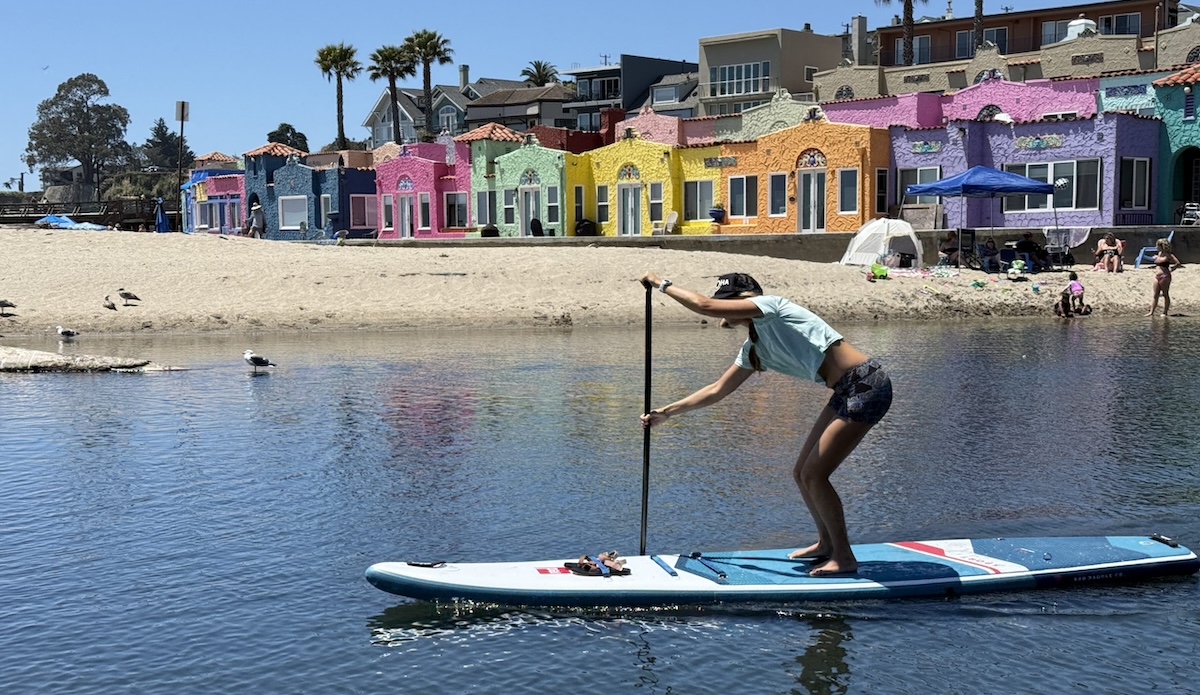
The Red Paddle Co. Sport Plus is a speedy board, making it great for long adventures on the water. Photo: Rebecca Parsons//The Inertia
Surf Paddle Boards
As the name suggests, surf paddle boards are for folks looking to catch some waves atop their SUP. There are both longboard and shortboard-style boards, but in general, SUP surfboards tend to be shorter and have less volume than other paddle boards. The lower the volume and the thinner the rails, the more high-performance the board will be (but it will also be less stable and trickier to paddle).
To learn more about surf paddle boards specifically, check out our guide to the Best SUPs for Surfing. Of all the SUP surf paddle boards we tested, our favorite high-performance shape is the Quatro Carve Pro because it’s lightweight, durable, and fun to ride. However, those looking for a more approachable shape that can also work for flat-water cruising should check out the Surftech Generator.
Size, Shape, Materials, and Overall Performance
Generally speaking, longer, narrower boards are faster, while wider, shorter boards move more slowly. Long, narrow boards like the Red Paddle Co. Sport Plus are more hydrodynamic, and they track well through the water, providing a more efficient glide. On the flip side, narrower boards are less stable and better suited for more experienced paddlers who prioritize speed over stability.
Where long, narrow boards are fast, wider or shorter boards move more slowly through the water. The added width doesn’t allow them to cut through the water as efficiently, and they have a bit more drag. Although they’re not as speedy, wider boards like the ROC Kahuna, the BOTE Breeze, or BOTE Lowrider offer a lot more stability and are great for beginners or larger paddlers. Shorter paddleboards are often more geared towards the surf, where that decreased length leads to greater mobility while riding a wave.
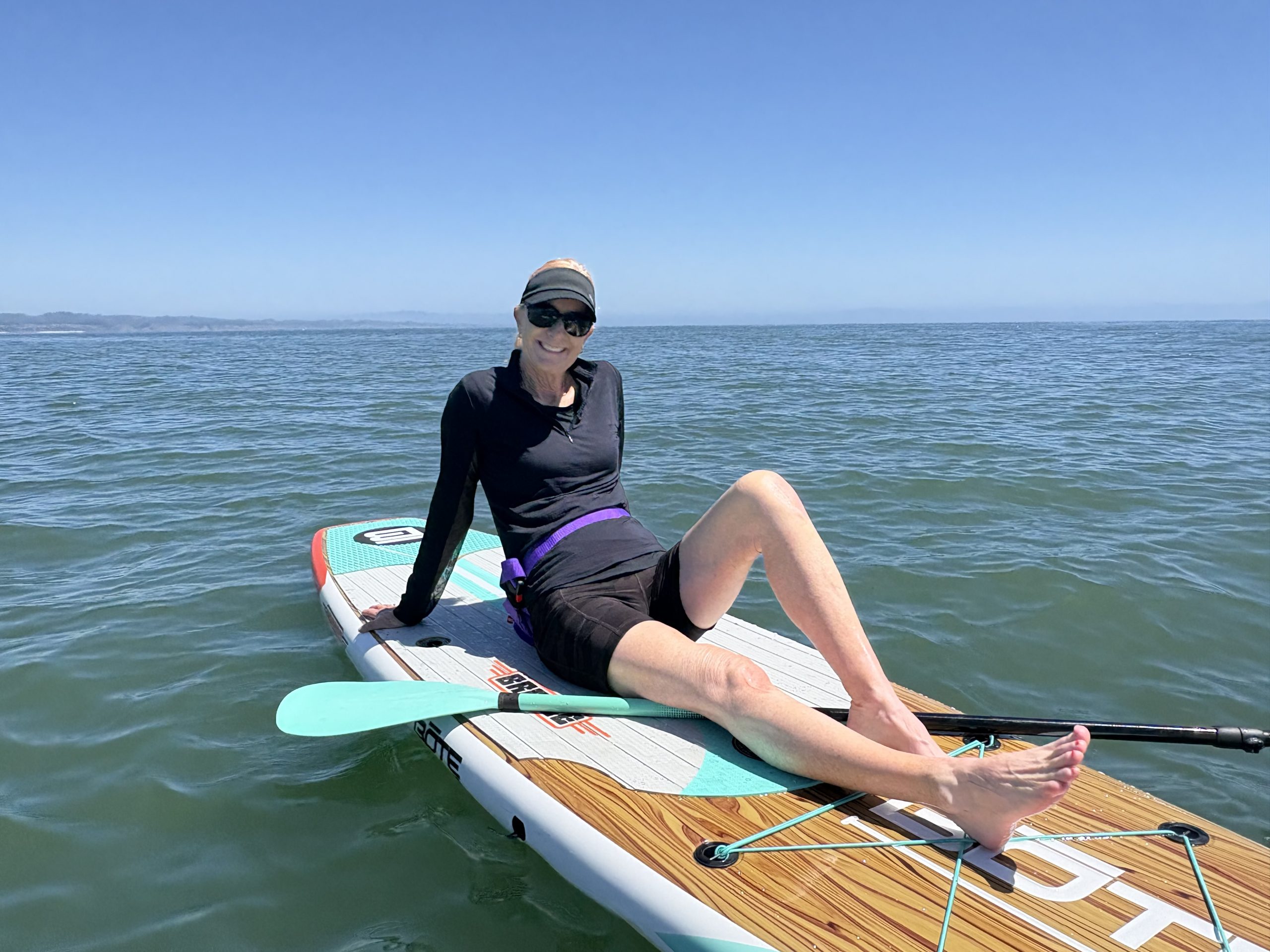
The BOTE Breeze Gatorshell is a wide, high-volume board that is incredibly stable. Photo: Rebecca Parsons//The Inertia
In addition to length and width, volume also plays a role in the board’s stability and weight capacity. If you remember from your school days, the overall volume of an object is the length x width x thickness. Boards with less volume tend to be less stable but can be more maneuverable and are better suited for smaller or more experienced paddlers (surf SUPs typically fall into this category). High-volume boards like the ISLE Explorer 3.0 (336 liters) tend to be much more stable and work well for riders of all sizes.
Another factor that affects the performance of the board is the materials that it’s made from. The most common materials used to make hardboards are epoxy or fiberglass. Inflatables are made from PVC. While there are some touring and raceboard-style inflatables, epoxy and fiberglass boards tend to be higher performance as their hard surface allows them to cut through the water quickly and efficiently.

The Wavestorm SUP Yak is wide and stable, and its all foam construction gives you a soft landing should you take a spill. Photo: Rebecca Parsons//The Inertia
Construction and Features of Stand Up Paddle Boards
When you purchase a paddle board, you usually get more than just the board. Most hardboards don’t come with much, but typically, the fin and deck pad are included. Inflatables, on the other hand, often come as a package including fins, a leash, a paddle, a pump, a bag, and other extras.
Fins
If you’ve ever tried paddling without fins, then you probably learned the hard way that they are essential. Fins help the board track in a straight line through the water and also aid in stability. Some boards have removable fins, while others have fins that are permanently affixed to the board. The most common fin configurations are single-fin, twin-fin, 2 + 1, quad, and five-fin setups. Some boards, like the Pau Hana Malibu Tour, only come with one fin box, forcing a single fin setup, but others, like the Quatro Carve Pro, come with multiple, allowing you to experiment with different configurations.

A single-fin setup is common. Pictured: the Pau Hana Malibu Tour. Photo: Rebecca Parsons//The Inertia
All-around paddle boards like the ISLE Explorer 3.0 typically have a 2 + 1 fin configuration, as it offers good stability. Occasionally, they will have a single-fin setup. Touring boards usually have a single fin because they track well and add stability, but will sometimes opt for a twin-fin construction, as is the case with the Red Paddle Co. Sport Plus. The fin configuration on surf SUPs truly runs the gamut, and really just comes down to personal preference.
Paddle
Like boards, there are many different types of paddles out there (here’s our review on The Best SUP Paddles). There are two main categories of paddles: adjustable and fixed length. Adjustable paddles allow you to easily change the length of your paddle, so you can experiment with different lengths or use the same paddle for riders of different heights. Adjustable paddles are popular due to their versatility. Fixed-length paddles are not adjustable, so it’s important to make sure you purchase the correct size for your height and the type of paddling you plan on doing. Fixed-length paddles also tend to be lighter and more high-performance.
The most common materials paddles are made from are plastic, aluminum, fiberglass, carbon fiber, and wood. Plastic paddles are durable and affordable, and are what most entry-level paddles are made from. Aluminum shafts are often paired with plastic blades and are a step up in performance from entirely plastic paddles. Fiberglass and carbon fiber paddles are lightweight and stiff, and are a high-performance paddle option (but they are typically more expensive). Finally, wood paddles are traditional but are heavy and expensive, and are best suited for wall art rather than for actually taking on the water. Some paddles use a blend of materials: The shaft is made from carbon fiber, but the blade is nylon.
Deck Pad
The deck pad sits atop the board and provides a cushioned surface for sitting or standing. Some deck pads span the entire length of the board, while others are just under the area where you would stand, like the one on the Pau Hana Malibu Tour.

The Pau Hana Malibu Tour has a squishy deck pad on the portion of the board where you stand. Photo: Rebecca Parsons//The Inertia
If you’re planning to do solo flatwater cruising, a deck pad covering the entire board is unnecessary, but if you plan to paddle with extra passengers onboard, do yoga, or walk up and down the board, then it’ll be essential. Some deck pads have a raised stomp pad towards the rear of the board, which is important for surfing or when doing quick pivot turns.
Carry/Grab Handles
Stand up paddle boards aren’t the lightest or easiest to transport, so handles are essential. Every basic SUP should come with a center handle for carrying the board, but some include handles on the front and back of the board as well. Some handles are padded and comfortable to carry, while others are hard and dig into your hands (something to note before purchasing a board).

Inflatables often come with extras like paddles, leashes, pumps, bags, and more. Photo: Nick Bruckbauer//The Inertia
Extras
Typically, hardboards and surf SUPs don’t come with a lot of extras – you’re lucky if the paddle is included. But inflatables often come with all the bells and whistles, often including extras like a leash, integrated D-rings, front and back cargo webbing, kayak seats, SUP/kayak hybrid paddles, built-in paddle holders, camera mounts, a PFD, and a bag.

Double-checking your PFD before you paddle out is always a good idea. Photo: Stacey A//The Inertia
Rules/Regulations and Safety
Before setting out to paddle, you should always take safety and local rules and regulations into consideration. If you’re not familiar with the local rules and regulations, take some time to look them up online and ask around before heading out.
Rules vary from region to region, but according to USCG regulations, any paddler over the age of 12 must have a “USCG-approved Type I, II, III, or appropriate Type V” life jacket. Children under the age of 12 must wear their PFD while paddling. It’s good practice to always wear a PFD because, as the old adage goes, “better to be safe than sorry.” Same goes with a leash – although it isn’t a legal requirement in most places, it’s always a good idea to wear a leash to prevent getting separated from your board should you fall.
SUP surfing works a little differently. You aren’t required to wear a PFD while surfing, nor are you required to wear a leash (in most regions), but it’s common courtesy to wear one to help keep everyone around you safe. It’s also worth briefing yourself on the rules of the lineup before dropping into your first waves.

It’s always good practice to wear a life jacket. Photo: Will Sileo//The Inertia
Weight, Transport, and Convenience
Before purchasing a paddle board, you should ask yourself a few questions to determine what kind of board you need. Do I have somewhere to store the board? Do I have a way to transport it on my vehicle? Will I be able to carry it on my own? Do I want to travel with my board?

Inflatables are easy to carry, transport, and store. Photo: Jack Bober//The Inertia
If you’re short on storage space, an inflatable board may be the most viable option. The same goes for a reliable vehicle. If you don’t have a way to transport a 10-foot-plus board on your car (racks and straps), then you shouldn’t get a hardboard. Typically, inflatables and surf SUPs are lighter than traditional hardboards, so if you’re concerned about weight, you might want to steer clear of a classic hardboard. Finally, if you want to travel with your board, especially on an airplane, an inflatable is going to be a much easier option as it can easily fit in the trunk of a car or can fly as checked baggage.
Weight varies greatly among paddle boards. The heaviest board we tested was the Wavestorm SUP Yak at 35 pounds, while the lightest was the Quatro Carve Pro at just 14 pounds.
Return to Comparison Table | Return to Top Picks
Editor’s Note: For more inflatable paddle board options, check out The Best Inflatable Paddle Boards. Want more surf-specific options? Read The Best Stand Up Paddle Boards for Surfing. We’ve also reviewed The Best SUP Paddles and The Best Lifejackets for Paddleboarding. Need something to wear when paddling? Here’s our guide to The Best Board Shorts, The Best Sun Hats, and The Best Rashguards. For more paddling gear reviews and features on The Inertia, click here.




